
TLD Application: Registry
Operator's Proposal
15 August 2000
GENERAL INFORMATION
D1.Introduction
II. BUSINESS CAPABILITIES AND PLAN
D12. Introduction
D13. Introduction
D13.1.1. Company information.
D13.1.2 Current business operations.
D13.1.3. Past business operations/entity history.
D13.1.4. Registry/database/Internet related experience and
activities.
D13.1.5. Mission.
D13.1.6. Management.
D13.1.7. Staff/employees.
D13.1.8. Commercial general liability insurance.
D13.2. Business plan for the proposed registry operations.
D13.2.1. Services to be provided.
D13.2.2. Revenue model.
D13.2.3. Market.
D13.2.4. Marketing plan
D13.2.5 Estimated demand for registry services in the
.PID TLD.
D13.2.6 Resources required to meet demand
D13.2.7 Plans for acquiring necessary systems and facilities
D13.2.8 Staff/size expansion capabilities
D13.2.9 Availability of additional management personnel
D13.2.10 Term of registry agreement.
D13.2.11 Expected costs associated with the operation
of the proposed registry
D13.2.12 Expected revenues associated with the operation
of the proposed registry
D13.2.13 Capital requirements
D13.2.14. Business risks and opportunities.
D13.2.15. Registry failure provision.
D13.3. Pro-forma financial projections.
D13.4. Supporting documentation.
D13.4.1.: Registry operator's organizational documents.
D13.4.2.: References.
D13.4.3.: Annual report.
D13.4.4.: Proof of capital.
D13.4.5.: Proof of insurance.
III. TECHNICAL CAPABILITIES AND PLAN
D14. Introduction
D15. Introduction
D15.1. Detailed description of the registry operator's
technical capabilities.
D15.2.1 General description of proposed facilities and
systems.
D15.2.2. Registry-registrar model and protocol.
D15.2.3. Database capabilities.
D15.2.4. Zone file generation.
D15.2.5. Zone file distribution and publication.
D15.2.6. Billing and collection systems.
D15.2.7 Data escrow and backup.
D15.2.8 Publicly accessible look up/Whois service.
D15.2.9. System security.
D15.2.10. Peak capacities.
D15.2.11. System reliability.
D15.2.12. System outage prevention.
D15.2.13. System recovery procedures.
D15.2.14. Technical and other support.
D15.3. Subcontractors.
GENERAL INFORMATION
D1.Introduction
D2.: DADA Spa Via de'Pandolfini, 34/r 50122 Firenze - Italy +39 055
20351 +39 055 2478143 registraradministrative@dada.it
D3.: DADA Spa Palazzo B 10, IV piano 20090 Milanofiori (Assago - MI)
D4.: Corporation, Italy
D5.: www.dada.net
D6.: D-U-N-S Number 63 100 8539
D7.: 5 (five)
D8.: December 31, 1999 (12 months) 4.335.775 USD, June 30, 2000 (6 months)
6.474.419 USD
D9.: Please see page 70 of "Prospectus relating to the admission to the
Italian new market and the public offer for the sale and subscription
of the ordinary shares of DADA".
D10.: Maura Cannaviello Domain Service Executive, Massimiliano Pellegrini
Supervisor, Alessandro Sordi CEO of Company, +39 055 30351, +39 055 203941,
registraradministrative@dada.it
D11.: /
II. BUSINESS CAPABILITIES AND PLAN
D12. Introduction
D13. Introduction
D13.1.1. Company information.
D13.1.2 Current business operations.
D13.1.3. Past business operations/entity history.
D13.1.4. Registry/database/Internet related experience and activities.
D13.1.5. Mission.
D13.1.6. Management.
D13.1.7. Staff/employees.
(From D13.1.1. to D13.1.7.) Please see Part I - Information on DADA of "Prospectus relating to the admission to the Italian new market and the public offer for the sale and subscription of the ordinary shares of DADA".
D13.1.8. Commercial general liability insurance.
Tha Applicant has a pro internet professional insurance for any wrongful act of the Applicant and for every damage arising out from provisions of internet services, including, for example, failure of the computer system (i.e. any computer, computer software, data, network, protocol or part thereof), errors, breaches of duty or omissions from provisions to third parties of computer services (i.e. computer systems analysis and integration), internet technology services (i.e. any computer or electronic information technology services), internet media services, online access to the internet. The insurer is A.I.G. Europe, with its head office for Europe in Paris, France. The period of insurance has started on 24:00 P.M. of 26 september 2000, and the limit of liability of the insurer is Lit. 4.000.000.000 (approximately corresponding to 1,815,000.00 USD). The applicant is now acting with the insurer to enhance the insurance. Please, for further details see the attached copy of the contract atD.13.4.5. of this application form.
D13.2. Business plan for the proposed registry operations.
PERMANENT IDENTIFICATION DOMAIN (.PID)
The proposed TLD has the following purpose and relevant features:
- Identification of people (over the net) by technical means
- Independence fromprotocol
- Double domain level mechanism
- Companies and other business clients
1) Identification of people (over the net) by technical means
The PID is much more than another simple TLD. It is a whole new concept
of existing on the net and in any other present and future communication
environment. Basically it gives to people the freedom to be reachable
and available at any moment and in any place. They only need a technological
means to be able to dialogue with other devices using the current protocols
or other standard protocols that could be eventually created in future.
Just to give a brief example of how it works let's assume a generic user
A is trying to send an e-mail to the user Michael Smith who previously
registered the PID domain name "michael.smith.pid". By typing such a domain
in his or her own mail client address field, the user A will be able to
reach Michael Smith wherever he is and whatever device he is using. How
is it possible? Largely based on strong interaction between the registry
and its registrars, the PID system is capable of:
- Detecting the user's client side application in order to properly
manage the request. If the A user is, for instance, using a mail
client it means there's message to be delivered. If the client software
used is a web browser it means the A user wants to have a look at a
web site. The data related to the client side application is passed
by the registry to the end user's registrar .The final protocol translation
process will be, anyway, executed by the registrar. It is important
to point out that the registry's sole activity is the one of passing
the data to the end user's registrar.

- Detecting end user's device in order to chose the needed protocol.
The registrar has to provide to each PID user a tool to manage his or
her availability. Using such a tool (the account page) the user communicates
to the Registrar the "rules" it has to follow in order to reach him
or her. Obviously the user is at any moment able to decide whether to
be reachable or not in order to fully protect his or her own privacy.
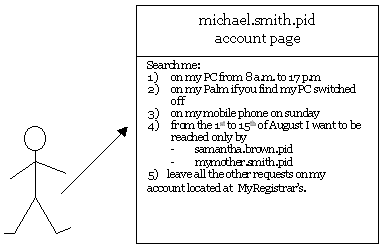
- Translating the request protocol into the needed one. The registrar has, at this point, only to translate the original protocol into the one needed to reach the proper device .

2) Independence from protocol
One of the most relevant features of this new TLD system is that it
tends to act as a sort of protocol manager. The system has been thought
out to properly address the current protocols andtheir future development
(i.e. IPV6) and any other protocol the internet community will decide
to implement in the future. As shortly described above this goal is reached
thanks to a technical architecture that is based on a strong interaction
between the Registry and its Registrar. The Registry's main activity is,
in fact, the one of managing the DB of the Registrars and their respective
registered PIDs. Once the request has been sent according to such a DB,
it is the target registrar which knows what device the end user is currently
using and therefore what protocol to use. Please for further technical
details see point D15.2.1 -General description of proposed facilities
and systems.
3) Double level domain mechanism
A double level domain mechanism has been created in order to address the
scarce availability of family name domains and to avoid cornering behaviors.
The mechanism is simple but nonetheless effective. According to the PID
structure, users can register a domain name that is composed of three
parts: a) TLD: .PID is obviously the property of the registry b) SLD:
it is the family name and it is property of the registry too. Every person
is free to use it. This will prevent any first registrant of each possible
family name from blocking the use of such a Second LD to other persons
with the same family name. It means that if John Smith registers the domain
john.smith.pid, he cannot prevent Paul Smith from registering the domain
paul.smith.pid. c) Third Level Domain: it is the name or the nickname
of people. The third TLD is property of the registrant and is subordinated
to the classic rules. It means that if John Smith registers the domain
john.smith.pid he can prevent another John Smith from registering the
same domain. The second John Smith will have, in this case, to find a
nick name. d) No sub-level domains are ammitted or required by .PID

4) Company and other business clients
At least in this first test phase the .pid TLD is only directed to
the permanent identification of people. A second phase implementing company
and other organizations .PID is highly protable.
D13.2.1. Services to be provided.
As a Registry DADA will have to provide these services to different subjects:
Registrars
Database maintenance: DADA will guarantee the maintenance of a global database where all the data will be recoverable. This database will be unique and centralized to avoid the danger to duplicate data.
Database sharing: DADA will permit to whole registrars to use and share the general database through a common interface and a personal password. Security will be guaranteed thanks to use of all new available technologies.
Dedicated account interface: every registrar will control its registering levels and every aspect of its management from a personal dedicated platform.
Management software: DADA will introduce a software or common software rules for all registrars so that to have a unique way of database managing. This software is very important to guarantee control and access in a equal way to every registrar.
DNS full compatibility: DADA will guarantee a full DNS compatibility to the whole Internet system. The DNS will be connectable to all present and future protocols.
Training period: DADA will give the possibility to all registrars to have a "knowledge period" into its structure. If some registrars will think to need a deeper and personal training, DADA will offer this services to everyone will ask for it.
Test period: every registrar will have to support a "test period" before the starting working period. The test will give to a registrar the possibility to start its domain managing in the fastest and best way.
User guide: DADA will give to registrars a user guide where all services and possible problems will be explained in an exhaustive way. The user guide will be useful every time a registrar will be faced with a problem.
Policies guides: every registrar will be provided with a policies guide that will have to be followed step by step to maintain the registrar position. Policies are fundamental to guarantee Internet stability so DADA will check in every moment the respect of all policies.
Service level agreement (SLA): DADA will guarantee to all registrars a good service level in every time and in every way. This one-side agreement is necessary to create the partner net and to guarantee Internet stability.
Invoicing system: a perfect invoicing system will cover all registrars needs: every invoicing system will be regulated in regard of each registrars' need.
Registry mechanism: it will cover also the third registration level so to create an unique registration and invoicing system: this work will create a common CGI to share information.
Dedicated registrar relation manager: every registrar will have a complete customer service for every kind of problem or question. Is important to guarantee a perfect registrar support to forestall and resolve all kind of problems.
Newsletter: DADA will provide a periodic newsletter where all Internet problems will be faced. Every registrar will be invited to participate to have useful information to improve DADA services and work.
Maintainers/Resellers/Business partners
Specific contract: maintainers will need a specific contract to define their position and possibilities.
Dedicated maintainer panel: from this area every maintainer will control the number and the status of every registration applied.
Special prices: prices will depend on the number of registrations made during determined periods.
Faq dedicated: they will be focused on maintainer problems and questions.
Help desk: it will be by e-mail.
D13.2.2.Revenue model.
Revenues are mainly expected from the massive amount of registrations. No other services is planned except those closely related with the maintenance of the data base, such as the maintenance itself, training and tests periods for registrars and so on. The focus of the revenue model is totally concentrated on widening as much as possible the registrar base and, therefore, the total number of end users (registrants) DADA plans to spin off an autonomous company. Such a company will be exclusively devoted to the registry activities. Among all the other business activities the original structure will practice the activities of registrar. The registrar unit will have to follow all the rules the other registrars have to. This structure guarantees that:
- the registry will be exclusivly devoted to such activities in order to grant an high quality of services.
- the competitive environment will be safeguarded.
The registry's revenue model is then exclusively composed of income from services distributed to registrars:
- registration fees
- data base maintenance fees
- training and testing fees
- software license fees
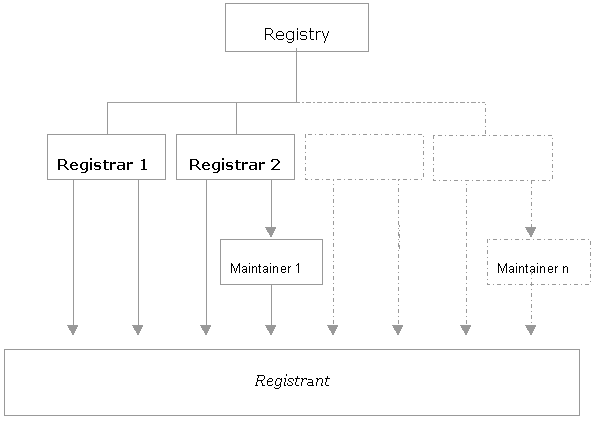
Registrar's competitive scenario
One of the main goals of the registry is to enhance competition for registration services. As reported by the ICANN Yokohama Meeting Topic document, there is "widespread dissatisfaction about the absence of competition in domain name registration". DADA believes that the introduction of the PID TLD, beyond being a means by which permanently identifies persons, is a way to boost to the competitive scenario as well. Price will not be the only competitive driver. Future registrars will have to provide PID users a wide range of integrating high value services. The range of such services is potentially endless being that most them are not yet imaginable. Just to give a couple of examples:
Registrars can provide various protocol translation services creating partnerships with other firms in order to widen to the services supported:
- Mobile and phone services
- Digital sign like services
- Multi user games
It is likely that the first group of PID registrars that will be composed of ISP/ASP and registrars of traditional TLD (.com, .org, .net, .etc) will have greater chances to be accepted by the Registry thanks to the expertise they gained.Being a PID registrar will, obviously, give them a significant chance to increase their incomes. Services and products they can offer to the new clients base reached thanks to the PID registry activities are:
- Web Hosting
- Special plugs on web hosting: Personal productivity tools: Personal Organizer, Personal finance, Booking and Reservations Storage tools: Virtual hard disk, Back-up, File Sharing Collaboration: Meetings, Conference, File Sharing, Personal Finance: Internet Banking, Spy-stocks, Insurance, Bill Payment
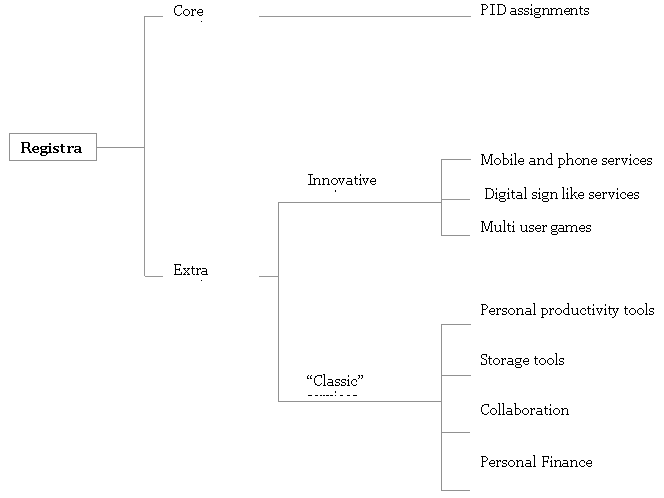
D13.2.3. Market.
New .PID domains can only be registered by individuals, with the limit of 1 domain per person. Theoretically speaking, the market size is limited by the total number of the world population, in the same way in which personal ID numbers should tend to the world population number. Practical considerations suggest to consider, in this first test phase, only the number of people with Internet Access and the number of cell phone subscribers, or generic mobile access subscribers. The first group of people are already used to reach resources on the Net by means of domain names and will very easily adopt the Permanent Identification Domain as the most practical and useful way to locate and reach person through any kind of technological means. Cell phone and mobile access subscribers will eventually adhere to the PID system being that this second group of people has obviously a higher degree of mobility and an higher need to be located and reached, whenever they decide to, through Internet access, mobile phones, GSM, pagers, etc. The continous increas in the offer of different technological devices, very often each one with its own protocol, has created an esponential demand for gateways and protocol-translators. It is very likely that every person of this(se) group(s) has some 10+ different "addresses", including but not limited to the follows, often used by different communication vehicles:
- Phone number(s)
- Voice
- Voice mail
- Answering machines
- Fax number
- Pager
- Cell phone number
- Answering machines
- SMS
- WAP
- UMTS
- Email address(es)
- POP3
- IMAP
- Web Mail
- Web Addresses
- Personal web page(s)
- ICQ
- Instant Messanger(s)
- LDAP
- Directory Services
- NetPhone(s)
D13.2.4. Marketing plan
DADA, as a registry, competes for the new TLD assignment because it has:
- creativity;
- consolidated experience;
- good ideas for the internet community;
- the capability to protect intellectual property ;
- Internet stability knowledge;
- capabilities to reach the Internet communities unmet needs.
We know the PID is a challenge, but it is much more than a simple new
TLD: it is a new Internet concept, it is a brand new Net point of view,
it is the connection between all communication systems, it is the bridge
from the today technologies and the next generation of devices, it is
a lifestyle, it is the unmet need the Internet was looking for. DADA has
the knowledge and capabilities to improve the dot PID and wants to do
this in the better way.
A new concept is not easy to introduce on the market, but every successful
concept, after a short introduction time gives explosive results for popularity
and incomes. Looking at the domain registration curve and the new Internet
community needs we think our idea will be successful and productive. The
TLD market is growing very fast and we want to put our .pid idea onto
the growing market [see statistics from www.dotcom.com/facts/quickstats.html]:

Today the three most famous TLD are dividing their importance into these
percentages:
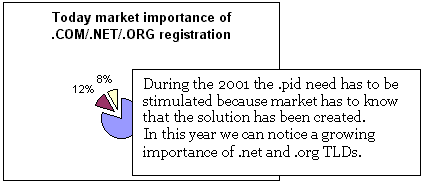
Our brand new .pid will not be a cause of market instability but will
be a market booster: .PID will not grab other TLDs shares but will help
the growth of Internet community DADA thinks that the market share for
the next 3 years will be like this [see D13.2.12]:
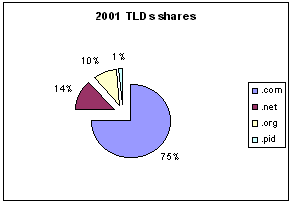
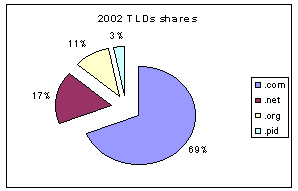

DADA's new TLD will not be a substitute for .com, .net and .org but will
give new possibilities to Internet community and to people to grow with
the Internet system. The estimated demand for registry service in the
new TLD [see D 13.2.5 ] is calculated with three different level of confidence
(10%, 50%, 90%):

Marketing strategy:
Dada will try to create a strong brand awareness in the short term. Our
partners can be affiliated if they can expect and have a short-medium
income vision: so our first task is to create the awareness in the market.
DADA will push its energies on every kind of association because it is
easier to target large numbers of users, then our marketing pressure will
be focused directly on registrars and final user.

We have to improve the market's awareness and because of this our marketing
strategy will be guided by an off-line marketing pressure focused on press
advertising. We need to target every kind of association because everywhere
there are groups and meetings our efforts can be much more aimed at the
community's consciousness. During the first year we have "to put to pasture"
associations with strong and effective actions, first of all with a press
campaign we will have to reach all opinion leaders, then with this "open
door" DADA will hit associations with their same army: organizing congresses
and conventions to cover the various associations' interests, giving brochures
and information, and everything that is connected with associations' life.
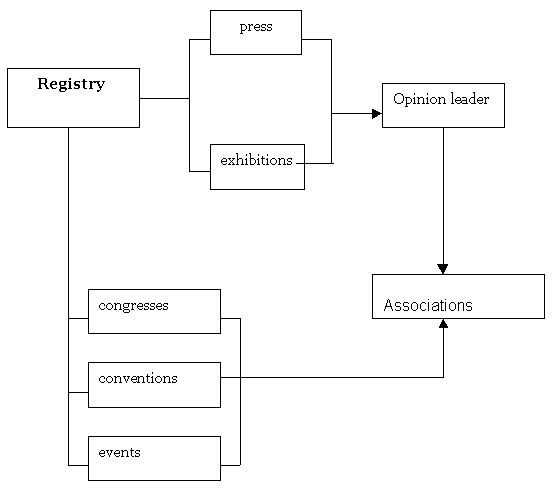
DADA, next to the associations' campaign, will start an advertising pressure
on the final user: DADA wants to fix its relation with the public through
a "super testimonial" that will be as a "nanny" for the Internet community.
Actually the need for a new TLD could bring confusion into Internet community
during the first phase of introduction, so thinking of a testimonial that
gets the user on the right road from the beginnig could be the solution
to the Internet user is initial disorientation. The right testimonial
has to be found for each country. It has to be someone who can express
concepts like security, knowledge and decision. DADA, through its portal
called SuperEva, has a great experience in "guiding" new users at their
very first contact with the Internet world as well as more experienced
users. To such a general support will be added a more specific media mix.
It will be a mixture between off-line and on-line advertising with a look
on every brand new advertising instrument.
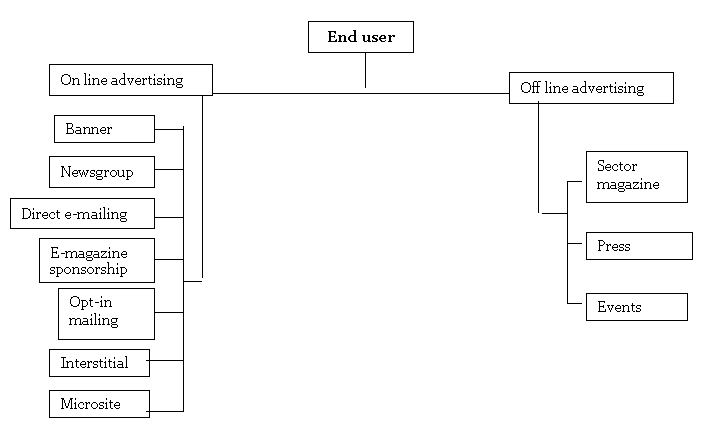
To reach the registers market, after the creation of market awareness
DADA will propose a different kind of partner program where the core promotion
will be based on the creation of value and help for the brand new affiliates.
We think a partner program can be divided into:
- affiliate program: this program is for every webmaster that wants to earn just putting a link on their sites: it's easy to use and it is a very fast way to increase our brand awareness;
- business partner program: it is used to reach every ISP that needs and wants to register domains and to sell our product on is site;
- international partner program: this program will be ready in the second step for all the ISPs that register a high volume of domains. There will be created an international links program with the purpose to share and reduce all the costs creating a "co-marketing net".
We will point our attention on customized support and for every affiliates there will be a promotional price depending on their registration and selling volumes.
D13.2.5 Estimated demand for registry services in the .PID TLD.
While the market size for gTLDs like .com, .net and .org domain names
is theoretically infinite, limited only by the possible characters combinations,
the .PID market size has a physical limit in the number of human beings,
the same as the mobile phones market. Practical and pragmatic considerations
dramatically reduce these figures to the number of people who can access
phone networks/operators, thus increasing the real market penetration
of mobile phones.

At the mean time the number of Internet Users has reached 251 millions,
with a market penetration of 4% of the total world population.

These 251 million internet users will register, by the end of September
2000, close to 25 million domains in the gTLDs only, approx. 32 millions
by the year end.


Easy to say, not all the internet users register a domain name. Network
Solutions mentions that there are today 2.5 domains per registrant, reducing
in this way down to 12.8 million the number of active registrant, including
companies, individuals, associations, institutions, etc. Possibly a significant
number of these registrants already have what they consider their own
personal domain.
Our recent experience with the Italian market, where individual can only
register 1 domain each while companies can obtain an unlimited number
of domains, proved that only 10% of the total number of domains is registered
by individuals as their unique domain.
Applying the same weight on the gTLDs, we can consider that by the years
end there will be 3.2 million domains registered by individuals as their
personal domains, while the remaining 28.8 million domains are registered
by the remaining 9.6 million registrants, represented by companies, institutions,
etc. or even by "duplicate" individuals as their second+ domain.

Considering Internet Users as the only valid universe, the market penetration
of personal domains has to be intended to be 3.2M personal domains on
251M internet users, equal to 1.3%.
Assuming for the personal domains a market penetration growth similar
to the one reached by the cell phone during the past years we can imagine
a similar trend:

It becomes crucial at this point the conversion rate of individual registrants
from a generic "personal" domain under a gTLD to their PID (Permanent
Identification Domain).
While we can assume that in the long run the proposed advantages of a
.PID respect any other gTLD will drive a registrant to definitively abandon
the other gTLD, we consider a realistic conversion rate for the initial
year to be close to 20%, growing year after year to almost the total of
supposed personal domains.

In the mean time, while other Registrars join the .PID registry and technological
evolutions make new features available to the market, new individuals,
who never considered and never would register a "personal" domain, will
opt-in for a PID, because of the benefits. This "premium" mktg penetration
will progressively add extra internet users.


In a second phase, thanks to new technologies, even cell phone subscribers
will register their PID. We can assume a market penetration of PID among
cell phone subscribers similar to the one obtained by the very same cell
phone penetration in real life. Eventually, the joining of one or more
mobile network to the PID system will make the growth even quicker, counting
on a consolidated base of subscribers and on an already widely accepted
and shared network

Confidence level for this estimates are as follow:

D13.2.6 Resources required to meet demand
Dada is planning to devote part of the proceeds of the recent IPO (around $80 milions) to meet the estimated demand. Basically the required resources are:
- Financial: we estimate a start-up investment of around $18 millions (year 1). According to our projected cash flow the maximum required amount of financial resources will be of around $10 millions.
- Technical: we are going to leverage on our experience as a registrar and on our thecnical R&D centre, which is one of the more skilled on the internet in Europe. Dada has historically developped in-house platforms for all its businesses, demonstrating excellent capabilities
- Staff: at the beginning Dada is going to leverage on internal staff, by re-directing some people (aound 10 people) with experience on domain registration architecture; later on a strong recruiting program is going to be implemented.
- Physical plant: Dada is preparing a new headquarter plant of around 7,000 sq. metres. This location will be by large suitable to sustain the staff growth. Dada has also its own data centre, a brand-new web farm (500 sq metres)
- Customer Service: Dada will organize a customer service department that will be internal managed for more sophisticated services and queries, while there will be an external supplier for common services and queries
D13.2.7 Plans for acquiring necessary systems and facilities
Following is a detailed plan for the resource planning.
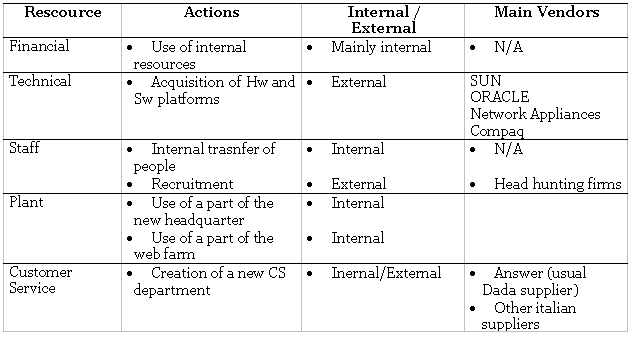
D13.2.8 Staff/size expansion capabilities
- Plans for obtaining resources: Dada's location is today a real competitive advantage. The headquarter is located in Florence which has one of the main Italian University and is quite far from Milan (the real centre of business in Italy). This allows DADA to have a good fishing process.
- Hiring policy: Dada is a very attractive employer. Lot of applications are every day managed by the HR dept. Also retaining process is quite effective: it is based on performance based compensation mechanism. Turnover today is very low (historically under 1%).
- Training: training policy is basically on the job. Job rotation and enrichment are used in Dada.
- Staffing levels will be:
- Technical dept.: junior analyst, senior analyst, manager, director
- Network dept.: assistant sys admin, chief sys administrator
- Registry operations: registry operator, registry supervisor, registry manager
D13.2.9 Availability of additional management personnel
At the beginning Dada will leverage on its management team. Additional management people will be searched in the market.
D13.2.10 Term of registry agreement.
The term for registry agreement will be of four years. At the end of the period there will be a re-bidding process in order to reassign the the TLD database management.
D13.2.11 Expected costs associated with the operation of the proposed registry
Expected costs are divided into the following:
- Marketing costs: costs associated with the brand building process. The investment share focussed on the spreading of the new TLD brand at a worldwide level. See marketing plan for further details
- Architectural costs:
- Hardware and software costs,
- research and development costs have been estimated as a percentage of the revenues,
- contribution to ICANN
- Organization costs:
- Personnel costs
- G&A (administration, HR, planning and control, logistics) estimated as a 40% of total personnel costs
The following table summarize the total costs.

Please note, that costs have been estimated according to the best scenario
in terms of volume (10% confidence level)
D13.2.12 Expected revenues associated with the operation of the proposed registry
Growth of revenues is directly linked to volume of registrations. We can divide the revenue stream into two blocks (see revenue model for further details):
- Revenues from registry operations We assume to charge 6$ for each
registration and 6$ for the one-year mantainance of a registered domain.
The amount will sligthly fall down (conservative assumption) in the
years to come. The revenue figures shown in the table below are based
on the worst case 90% confidence level.

- The volume of registered domains is the one of the worst scenario (90% confidence level). A conservative churn rate has been foreseen (5%). - Revenues from registrars
We assume the registry will charge to registrars:- set-up fee: covering all required activities to put the registrar on-line,
- annual fee: covering the right of being a registrar,
- training fee: covering training for registrar staff,
- license fee: software for re-selling of registration according
to anASP model, simply requiring the graphical interface of the
registrar (we assume 50% of registrars will use the registry platform).

D13.2.13 Capital requirements
Dada intends to finance the implementation of the registry operations through the IPO proceeds. The financing through external sources is a contingecy option, to be activated if required. External researches (Intermonte Securities, dated Setpember 2000) estimate the WACC of Dada in 10,5%. Today Dada is leveraging on external financial resources at a rate of around 6,5%.
D13.2.14. Business risks and opportunities.
Business risks are ranging and connected with the activity of domain registration. Below is a list of business risks: · the mass of traffic could degrade the architecture, especially with rush of registrations at the opening of the TLD · the value proposition for the TLD could be misunderstood and the volume of registrations could not come out as epected, the internet population could not rise according to the expected growth rates · Dada could not be able to manage the growth in terms of: · hiring people, · updating and strengthening the technological platform, · manage the organizational growth
D13.2.15. Registry failure provision.
The eventuality of a bankruptcy of Dada S.p.A. is theoretically possible, even if this eventuality is extremely improbable both for the resources and the economic structure of the company and for the Italian law on bankruptcy. The structure of the company comprises an important part of the shares in the property of the Poligrafici Editoriale S.p.A., one of the biggest Italian publishers in terms of patrimonial and financial resources This element, joined to the support of one of the more important financial Italian banks, Mediobanca Banca di Credito Finanziario S.p.A, makes bankruptcy of the company extremely unlikely and, above all, guarantees important financial resources in order to get an eventual agreement with the creditors in case of future and at this moment unpredictable economic difficulties. The availability of these economic resources and financial emergency support is also particularly important in virtue of the Italian law on the bankruptcy, granting the society in difficulty, and above all the great enterprises in difficulty, many legal institutes ( the Italian "Concordato preventivo e fallimentare") finalized to explore the possibility to avoid bankruptcy in exchange for one partial satisfaction of the demands for the creditors.
D13.3. Pro-forma financial projections.
The following financial projections are based on revenues related to
registry operations and on costs related to marketing, architecture and
organizational costs. No estimation has been made for financial costs
and taxes. This is due to the fact, that financial costs and tax influence
on the Dada Income Statement and Balance Sheet will be drowned amongst
the financial positions of the other business units.
A. First year quarterly-based financial projections

B. Five year financial projections


D13.4. Supporting documentation.
D13.4.1.: Registry operator's organizational documents.
Please see floppy disk number one "Corporate Charter" and "Statute"
D13.4.2.: References.
Please see Part I - Information on DADA of "Prospectus relating to the admission to the Italian new market and the public offer for the sale and subscription of the ordinary shares of DADA" page 35.
D13.4.3.: Annual report.
Please see "DADA S.p.a. Half-yearly report up to 30th June 2000"
D13.4.4.: Proof of capital.
Please see " DADA S.p.a. Half-yearly report up to 30th June 2000"
D13.4.5.: Proof of insurance.
Please see "Our proof of insurance".
III. TECHNICAL CAPABILITIES AND PLAN
D14. Introduction
D15. Introduction
D15.1. Detailed description of the registry operator's technical capabilities.
DADA spa is one of the most important ISP in Italy. It has a long experience
in domain registration either in ccTLD or gTLD. In fact, DADA spa is the
unique company accredited by ICANN, for the Italian market as registrar
for .com, .net and .org. Also, DADA spa has an aggreement with Network
Solutions Inc for the activity of registrar. The DADA spa activity is
based on all what concerns internet. It has developed its own portal known
as Supereva. Currently, 1.600.000 subscriptions to Supereva have been
reached. Moreover, DADA spa has exceeded more than 22.000 registred domain
names.
The technical staff is formed by a a group of 20 programmers and 10 system-analysts
and software engineers. Moreover, a group of 10 system integrator is concerning
about internet connectivity and the monitoring of the network.
Different programming tools and languages, like C,C++,Perl, Java, JavaScript
are used in a wide varierty of operating systems, Unix, Linux, Windows.
D15.2 Technical plan for the proposed registry operations. Introduzione alla domanda
D15.2.1 General description of proposed facilities and systems.
The proposed technical solution for registry activity is drawn below.
Registry system overview
In order to achieve the requirements imposed by ICANN to be accredited
as registry for a new TLD, to ensure a high quality of service for all
of registrars and the internet comunity, and to mantain the internet's
stability we plan to develop a system having the components as reported
in Fig.1
The scope of the proposed TLD is providing internet people with a
unique address to be used to reach other people independently from the
device used by the destination. The sender knows only the unique address
of the destination. The receiver can use a certain number of devices to
to get his messages.
A short explanation about how the system should work is presented here.
Consider that a generic end-userA would to reach a registrantB. We suppose
that a registrantB has already registred his own domain with the registry
operator of .PID tld as michael.smith.pid by means of services
offered by registarB. The interaction between the end-userA, the registrantB,
the registry and registrar is carried out as following :
- The end-userA inserts the address of the registrantB to be reached as michael.smith.pid
- The browser start the resolution name phase to determine how can be contacted registrantB. In this phase, are involved the end-userA configured DNS and the registry name server which gives back to end-userA the address of registrarB.
- The end-userA system specifies to the registrarB the complete address of the destination to be reached (michael.smith.pid)
- By extacting the registantB record configuration from its own database, the registarB can decide how to contact it. It gives back to the end-userA system the needed information about the Added Service Provider to be contacted.
- On the basis of these information the end-userA system can create a link with the Added Service Provider to send the final message .
Notice that in all of the previous steps, the only action requested to
the end-userA is the typing of the destination address as michael.smith.pid
The interaction between the end-userA, the registarB and the Added Service
Provider is handled by means of a dedicated plug-in that can be downloaded
by the end-userA automatically, when the registarB or the Added Service
Provider systems are reached.
Only at the end of the process ( step 4 ), the protocol to be used ( HTTP,
e-mail, fax, phone,sms,…..) is decided. Moreover, it is the role of the
registrar to keep the infirmation concerning the mean by which the registrant
can be contacted. Obviously, the registar can decide how to allow the
registrants to configure their personal way to be contacted.
All these activities are supposed to be carried out by a wide range of
registrar, each of them is free to decide how to offer the service to
its registrants. Moreover, a large number of specialized Added Service
Provider can be involded.
This kind of architecture allows a single registrar to distribute the
offered services among a certain number of Added Service Provider. In
this manner, the registrar can focus its activity on what concerns the
registration of the domains and the configuration of a single registrant.
The other activities which concern the transformation of the message to
be compliant with the device used by the receiver are delegated to a the
Added Service Provider which can offer their experience to the registrar.
At registry level, the services provided are regarding the registration
of the new domains for the authorized registars and the resolution of
the domain name for all of the internet comunity.
The main feature of the system is its capacity to be shared and accessed
by a relevant number of authorized registrars. In this document, the registrar
is the company or entity responsible to make a single end-user able to
register a domain with a new TLD.
This section gives a short description of the sub-systems. The following
sections provide more details about the aspects regarding the registry
activity as reported in [New TLD Application Instructions ] released by
ICANN on 15 August 2000.
Our system can be viewed as composed by a certain number of sub-systems,
each of them is designed to be used by one of the actors involved in managing
domain names. At operational level, the system can be accessed by registrars,
internet comunity and the internal staff ( technical, support,etc…).
A : Production and test environment :
Servers for a test and production purposes carried out by registrars.
We assume that a registrar, that has been accredited by ICANN for a new
TLD, must perform the acceptance test which consists in a set of tasks,
fully documented by registry, that registrar must execute successfully
before accessing to the production environment. The machine consists in
a SUN 3500 Entreprise equiped with 1GB RAM, 130 GB disk-space, 4 CPUs
and Solaris 2.8 version operating system. The machine has all of its hardware
components duplicated to constitute a really fault-tollerant system. We
project to run on it the servers and all the software required by the
interaction with registrars.
B : DB server cluster :
It consists of two SUN 4500 Entreprise configured in such manner to from
a cluster. Is used a sun cluster software for this purpose. Each machine
is equiped with 1GB RAM, 500 GB disk-space, 2 CPUs and Solaris 2.8 version
operating system. Its role is to carry out all of the operations on database.
We will use Oracle 8.1.6 Entreprise version as database system.
C: Monotoring system
This subsystem is intented to be used by technical staff of the registry.
It includes all the aspects for the correct operation as the monitoring,
performing of the backup, restore, etc... . For this purpose, we plan
the use of a Compaq workstation.
D : Software development system :
Our conviction is that, in mission critical system, as must be a registry,
the separation between an internal software development environment and
the rest of the system shared by internet comunity is strongly recommended.
This sub-system consists of a series of machines each of them equiped
with an IDE ( Integrated Development Environment ) and basically used
by the internal development staff.
E : Added Service Provider system:
The system is out of the registry architecture, it is reported here only
to indicate the all sub systems involved in the tld .PID activity. The
registar has the free to select the Added Service Provider.
F : Customer service system :
It's purpose is to give the complete assistance for questions coming from
registars. Can be contacted by phone, fax or e-mail. Currently DADA is
provided with a similar system used daily for customer assistance. Consists
of more than one PCs, connected in so manner to form a call-center equiped
with ARU ( Automatic Response Unit ). From each PC, the operator have
the access to all of the information concering domains, registrars, stored
in the registry database.
G : Name servers :
Consists of two separated machines based on Unix operating system and
dedicated uniquely for the activities of primary and secondary name servers.
The machines will be located in DADA server farm currently in use, which
consists in a room with a temperature maitened, by three air conditioner
systems around 18°C. Also, the server farm is equiped with a sofisticated
backup supply power system able to ensure a normal operations for 24 hours
after a black-out. An independent power generator fed to diesel oil is
provided. Moreover, the building where the server farm is located has
a service guard carried out for 24 hours a day, 7 days a week.
Dada Internet connectivity is carried out by three upstream carriers :
Interbusiness ( Telecom Italia ) : 12 Mbps extensible up to 155Mbps
Infostrada : 12 Mbps extensible up to 155Mbps
UUNET : 18 Mbps extensible up to 155Mbps
D15.2.2. Registry-registrar model and protocol.
The interaction registrar-registry is based on the client/server model. The registrar is the client, the registry is the server. Mainly, the server offers some services to a registrars to allow them performing the following tasks :
- Add a nameserver
- Add a domain
- Delete the registration of domain
- Update some data of the domain
- Transfer a domain from a registrar to itself
- Query a domain name
- Renew a domain
- Extend a period of domain
- Modify the status of a domain. Helpful for dispute problems.
- Check the status of a domain
In order to make a registry services accessible by a wide range of registrars, we give them two possibilities to intercat with registry system.
Firt solution :
An HTTP secure server is running on registry system. The server is configured to be accessible only by authorized registars. The services made available are performed by means of CGI that registrars must call by inserting them in their client application. The description of the parameters to be passed to the CGI will be documented by the registry.
Second solution :
A TCP/IP based secure connection will be created by the registrar. On this connection, commands according to Registrar Registry Protocol are exchanged. The registrar must develop on the client side the software for handling the connection. For this purpose, the registry will distribuite to the registrars a set of API, as SDK package, to permit them an easy implementation of the client application.
The registrar will be free to develop its application selecting the operating system ( Unix, Linux, or Windows 95/98/NT) and the language ( C,C++,Java).
D15.2.3. Database capabilities.
As mentionned above, will be used Oracle 8.1.6 Entreprise. All the information regarding domains, registrars are stored in a dedicated database. The database type is designed to serve a system with high mission critical. A high level of scalibilty, availibility and realibility is ensured. The database server and the hardware used ensure the duplication of data by the use of fault-tollerant techniques. In the startup phase, the size proposed will be at least 100GB, with a throughput of 300 transactions/s. A set of SQL store procedures will be available to perform the operations of object creation, editing and deletion. A change notification are sent by e-mails to registrars. When a transfer request is issued by a registar, the domain is flagged in the database. The transfer procedure is executed by a daily batch job who notifies the request of transfer to registrar of record and to the gaining registrar. All the messages exchanged with the registrars about the domain under transfer are made by e-mails. If, no nack message is received by the registar of record by a certain numbers of calendar days, the domain is automatically transfered to the requesting registrar. In othre words, the transfer operation is made only with the conset of the registrar who registred the domain.
The grace period consists of a defined number of calendar days following the registry operation in which the domain can be deleted and no credit is issued to the registrar. The extent of the grace period will be defined according to registrars needs.
The grace period is provided in the following cases :
- Registration of a new domain
- Transfer of an existing domain
- Extention of the period of an existing domain
For each domain, the end of the grace period is reported in the database.
For the reporting purpose, an audit mechanism is implemented to permit
each operation performed by a registrar or registry, on a domain to be
logged. Are logged also the operations not successfully completed. These
information will be made available to registrar in ASCII format and can
be downloaded. For each operation, must be reported the at least the date,
the domain and the operation.
At least the following types of report are generated for each registrar
:
- Daily operation history : Reports the list of the transactions daily performed by a single registrar.
- Domains registred grouped by name server on which they are coinfigured.
D15.2.4. Zone file generation.
The subsystem dedicated for database operations is used also for the generation of the zone files. A dedicated batch procedure will be executed two times a day to extract the new information from the database. Then an update of the zone file is performed. The registrars can access the database for the editing, update operation by means of dedicated web tool. The modified information will be inserted in zone files during the next extraction of data from the database.
D15.2.5. Zone file distribution and publication.
The nameservers are running on different machines. The distribution of the zone files is performed by encrypted connection created to transport the zone files on the primary name server.
D15.2.6. Billing and collection systems.
Currently DADA uses a secure SSL connection for billing purposes. The service is daily used for hundreds of transactions.It has been started two years ago and it is continously extented and enhanced to cover a wide range of customers.
D15.2.7 Data escrow and backup.
All the data generated during the registry activities are the object of the backup. Also, a copy of the software used ( source, exe files, servers, operating system,… ) is done. A daily batch procedures will be executed to perform the backup of data. The backup files are compressed and stored on a dedicated machine formed by a diks array system. An optical device is provided to move the oldest data on CD-ROM once a week. Also, by using of the dump technique, all the information regarding the activities of the database are saved. This task is executed each day. A dedicated procedures will be available to retrive the data from the backup. A special attention is focused on the way the data are organized on the backup-devicee in order to make very easy and very fast the retrieval task.
D15.2.8 Publicly accessible look up/Whois service.
The lookup and whois services will be implemented according to the standard widely used. All the needed information about a domain, name, date of registration, name server,etc… will be available. These functionalities can be accessed by a web tool or by command line.
D15.2.9. System security.
For security purposes, are provided the following mechanisms :
- At physical level, the router capabilities are used to prevent an access from machines different from those declared by the registrars. This is performed by means of filter on the IP address in the production environment.
- The registry server accessed by registrars are SSL enabled in test and production environments.
- Only a commercial certificate released by trusted entities are accepted by the registry to establish an SSL connection.
- At each access, a registrar must authenticate itself by means of UserID an password established by the registry and comunicated in a confidential manner to the registrar. The userid and password are different for test and production environment. For more security, the userid and password will have a defined period of validity.
- At TCP/IP level, connections are established only for authenticated users.
D15.2.10. Peak capacities.
The system is designed keeping in mind the problems related to a high volume of transactions for operations on domains and resolution domain name requests. The system will be dimentionned to handle a specified number of requests so that the only the 60% of the system resources available are used. At techincal level, the system is continously monitored in order to have a detailed report on the use of its resources ( CPU, Disk, memory,…). Whenever, the behavior of the system indicates that the activity from registars is augmented, and the threshold of 60% is execced for a certain period of time, the system will be enforced by adding further resources to have always the 40% of the hole system available to tackle the unexpected high load. As we have a long experience in domain registration, we can define exactly how will be the volume of a daily request from registrar and the dimension of the system in the startup phase. Also, based on the scalabilty of all the components of the system, the update operation of the resources is relatively simple and fast.
D15.2.11. System reliability.
The quality of the service, is defined on the basis of the interaction with the registar and with the rest of internet comunity. The goal is to maitain the response time from the registry servers to registars confined in a specified values. Specially, the critical and most frequently performed operations from a registar on a domain, must have a response time very short and acceptable. For this purpose, a system for the measurement of the system performance is provided. The information about these measurment will be made available on line to the registrars. Also, all the operations requested by the provided services whois/lookup, name domain resolution will be executed by minimizing the response time.
D15.2.12. System outage prevention.
All of the hardware resources are duplicated. In particular, the disks are mirrored, the cpu, network cards, etc… are duplicated to ensure the availabilty of the service whenever a failure occurs. A monitoring system based on SNMP protocol is used to detect immediately the failure of the components. At each detected failure, an alarm will be generated and reported to the technical maintenance staff. A supply power backup is maintened. The daily performed backup, as mentioned above, servers to rebuild the system and to reduce at the minimum the risk of not availability of the service
D15.2.13. System recovery procedures.
The outage of the system can be caused by a hardware or by software failure. For the hardware failure, as described above, each critical part is duplicated, then the system automatically detects the failure and switches all the activities on the backup device. Then, the recovery procedure is executed by the system without human intervention. Moreover, the occured failure is reported, as all parts of the system are monitored, to the technical staff who start the provided procedure of substitution of the broken device. For the software failure, the critical applications are always under observation by a dedicated monitors. When, a failure occur, the applications will be immediately restarted. An unexpected deletion of the data from the disk is recoverd by restoring from the backup and the dump file for database reconstruction if needed.
D15.2.14. Technical and other support
For technical support, the ufficial languages used are the Italian for local market and English for the rest of the world. A customer service support is created and can be reached by e-mail, by phone or by fax. Also, a dedicated web site will be available with all the needed information about the registry activities. Moreover, an archive of all the e-mails exchanged will be created to form an useful FAQ. The registrar may also, access on the database of the registry to perform tasks for editing or consultation. The support is intented to cover all of the questions regarding the aspects involved in the registar-registry and registrant-registry interactions.
D15.3. Subcontractors.
No subcontractors will be involved in this activity.
_______________________________
Signature
_______________________________
Name (please print)
_______________________________
Title
_______________________________
Name of Registry Operator
_______________________________
Date